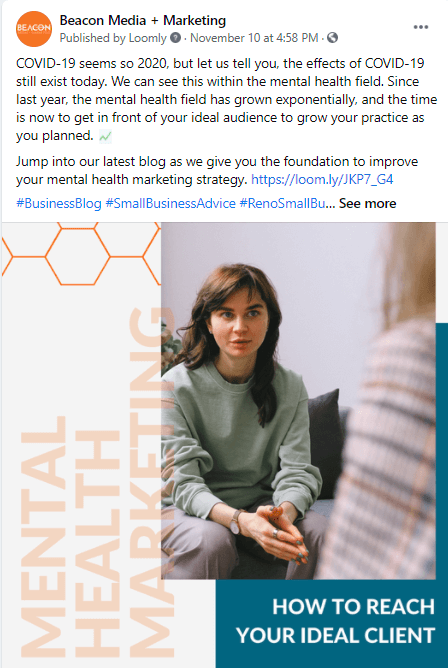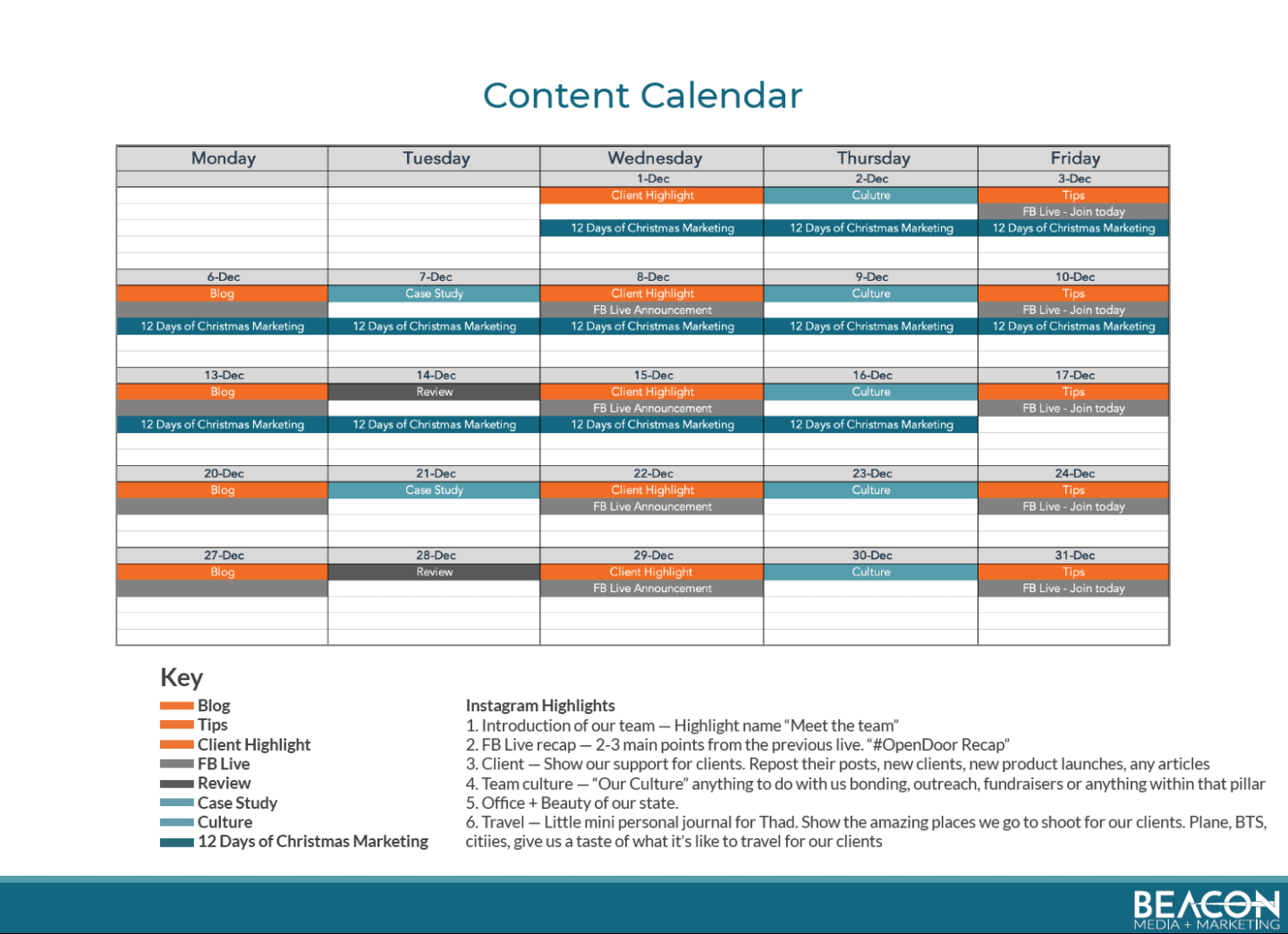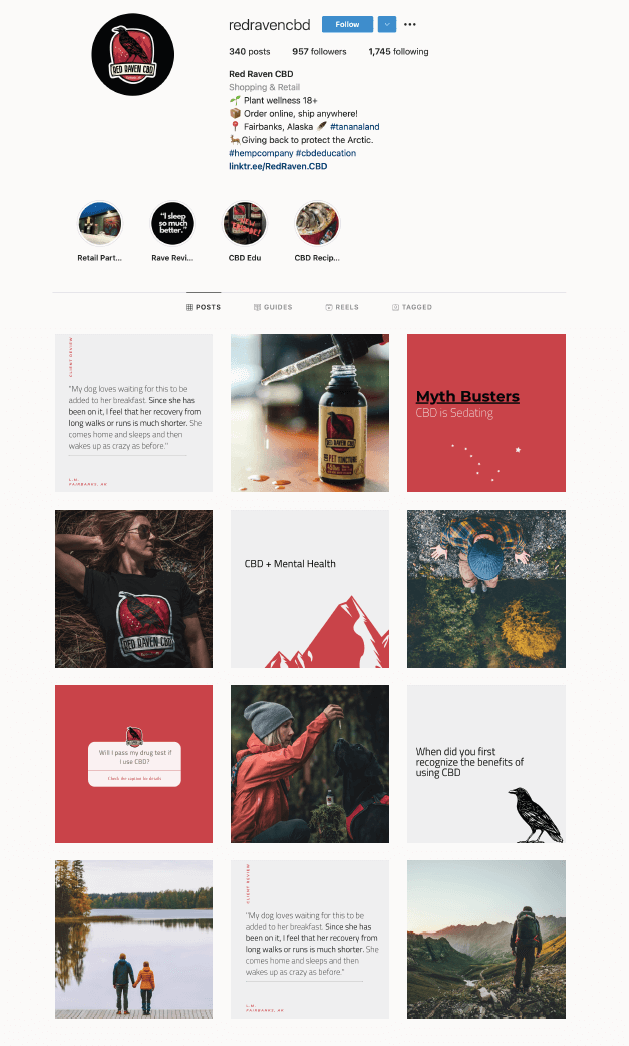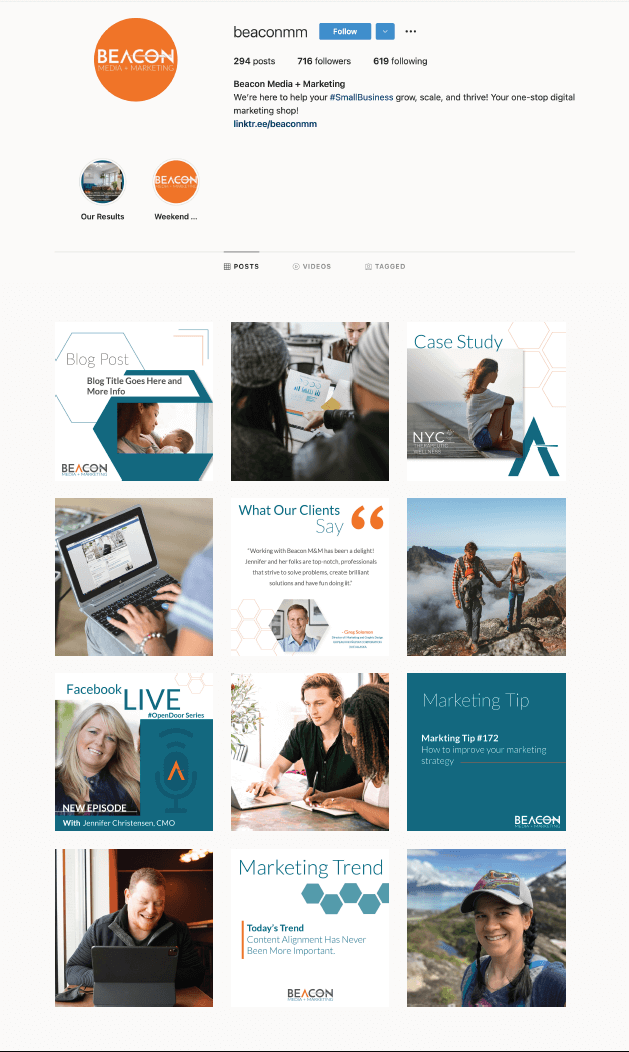Social media platforms are no longer just a place to watch cute cat videos and post what you ate for lunch that day. They have evolved into an effective spot for businesses to market their products or services online and develop a deeper connection with their customers. And for many businesses, a great social media content strategy is the primary way to generate leads and see substantial business growth.
In the past, advertising often felt like a shot in the dark. A business would put out an ad and hope it would bring in more leads. Now, social media invites conversation between businesses and consumers. People like, comment on, and share content they find engaging. And all of these reactions become trackable data businesses can use to narrow down their target audience and evaluate if their strategy is working.
At Beacon Media + Marketing, we’ve watched many of our clients flourish with a lead-generating social media content strategy. Here are just a few of the amazing businesses we’ve had the chance to work with that saw real results from working with a social media digital marketing company:
- Port Chilkoot Distillery gained 2,148 new Instagram followers and generated 290 leads in the first six months
- Premier Health and Medicine gained an average of 78 quality leads a month and tripled new patient monthly onboarding
- Anchor Lutheran School had 50K impressions on their social media video and saw a 34% increase in new student inquires
- Any Mountain achieved a national reach of 2 million people and received over 100,000 views on their video
With the right structure and a clear plan in place, you can see results like this for your business. However, it’s not enough to simply post on social media. If you’ve created a social media account for your business and haven’t seen much audience engagement or return from your posts, it’s time to reconsider your social media strategy (or maybe create one to begin with). Here are five steps for getting intentional with your digital marketing and creating a social media content strategy that generates real leads.
Want to leave the strategy session to the lead-generation experts? Here’s how we take your social media to the next level.
1. Determine Your Marketing Goal
At the core of your social media content marketing campaign is your marketing goal. It is the base for the following steps we’re going to discuss and is the metric you use to determine your success. You might be thinking that your goal is to generate leads. That is what we promised you after all, right? Knowing you want to generate leads is a great step in the right direction, but you need to digger even deeper and come up with more specific, measurable goals for your business social media. Do you have a specific revenue goal you’re trying to hit? How many leads a month is your business capable of handling? How many of these leads need to convert and become customers for you to meet your revenue goals? Is there a particular item or service you want to sell more of?
You also want to determine a reasonable timeline for these goals, remembering that it can take months for your marketing efforts to really take off. And if you have a long-term annual goal, break it up into smaller chunks to track progress. For example, if you want to increase sales by 200% in one year, you can track sales growth on a monthly and quarterly basis to make sure you’re working toward this objective.
2. Identify Your Target Audience
Your social media content shouldn’t be written to capture the attention of anyone and everyone who might be on social media. It needs to be tailored to a specific target audience that are the most likely to be interested in and purchase your product or service. This can be broken down by gender, occupation, age, hobbies, or essentially any criteria that the people you did business with have in common.
For example, one of our target audiences at Beacon is mental health providers who are seeking mental health marketing services to connect with clients or grow their practice.

Identifying your target audience in your social media strategy allows you to focus your money, time, and resources on people who are much more likely to engage with your content and turn into a lead. It also helps you strengthen your brand through the creative process, allowing you to focus on images and messaging that capture this specific audience group.
Not sure who your target audience is? Consider who you do business with most already. If you already have a social media account that’s been up and running for some time, look at who interacts with your content.
3. Choose Your Social Media Platforms
There are several social media platforms you can post content on, and not all of them are right for your business. You need to consider which platform will be most successful in helping you generate leads and accomplishing your marketing goal. And you need to know which social media platform your customers are actually using.
Let’s take a look at the top six social media platforms for business:
- Facebook: A popular social media marketing platform for all audiences, Facebook has over 2 billion users a month. Whether you’re a B2B or B2C business, Facebook is an effective place to create content, put out ads, and generate leads.
- Instagram: A platform that uses images and videos as content, Instagram is a great place to show, rather than tell, people about your offerings. There are over 1 billion monthly Instagram users, and it integrates seamlessly with Facebook. While older audiences are using Instagram more, this platform is most popular among younger audiences, with 71% of users being 35 and under.
- Twitter: Twitter’s audience is smaller at approximately 350 million users and is great place to post updates and news. Since twitter has a tweet length limit of 280 characters, you don’t need to curate long content to connect with your audience and create content that’s worth retweeting.
- LinkedIn: For B2B marketing, LinkedIn is a strong choice for social media content marketing. As a more professional, formal platform, LinkedIn marries conventional social media marketing with professional networking. It’s easier to connect directly with the decision makers who will making purchasing decisions for their business and gain trust with B2B clients.
- Pinterest: Like Instagram, Pinterest relies on visual content. However, this platform is unique as many people use it more like a search engine than to connect with others or share personal information. Pinterest is a place to learn new skills, increase productivity, find workout routines, or look for products to redecorate your house. It’s a great place to share information, like infographics and blog posts, and to market for an ecommerce business.
- YouTube: The top social media platform for videos, YouTube has over 2 billion users a month and reaches every demographic. It’s a social media platform and search engine in one, and people use it to consume a wide range of content, from educational and marketing videos to comedy and entertainment.
4. Create a Social Media Content Calendar
Do you struggle to post on your business social media accounts regularly? A social media content calendar is a great way to keep you accountable and bring structure to your strategy. It helps to plan your posts at least a month ahead. It might look something like this:

As you map out your month’s posts, here are a few considerations to keep in mind:
- You need to find the right balance for posting. While you want to post on a consistent basis, you don’t want to overdo it. Many people find the sweet spot for business social media posts is about 3-5 posts a week.
- Have a variety of content types. Get the word out about your new blog post, share an article on a relevant topic, post an infographic, add a new video or talk to your audience live. You can even assign a certain day of the week to a specific content type (e.g., you always post a video on Fridays.
- Always include a visual. People are often drawn to visual content and may scroll past posts that are only text. Always include some type of visual in your posts, whether that’s an image, an infographic, or video.
- Having a messaging plan. Your tone and voice should be consistent across all marketing and be created with your target audience in mind. Make sure every post you write is true to your brand and follows the same messaging strategy.
Your calendar can be as basic or complex as you want. You can simply layout your topics for the month or go a step further and include links for images, the title for your post, and a post snippet.
Social Media Calendar Template
Download our free social media calendar template for your business and start each month with a clear plan.
5. Generate a Social Media Graphics Template
We just mentioned how important visuals are for your social media posts. While your content calendar helps you keep consistent with your messaging and content distribution, a social media graphics template helps make sure every post is visually attractive and on-brand. This is especially important when posting on platforms like Instagram and Pinterest.
Here is an example from our client Red Raven CBD that showcases what a cohesive social media design looks like.

And here’s one more from our Beacon Instagram.

Satisfying, right? By pulling from each of these brands’ colors, bringing in the logo, and adding a few elements that are consistent throughout each post, we’ve created posts that are not only visually appealing on their own but attractive from a big-picture POV as well.
Want to know how we did it?
- Use a program like Canva or Adobe InDesign to create your graphics. If you’re looking for something that’s free or beginner friendly, Canva is a great choice.
- Establish a couple of elements you’ll use throughout your posts. For example, Red Raven CBD uses the crow from the logo, mountain imagery, and the color red.
- Create a template for each kind of post you’ll be doing. You can use one template for testimonials, one for blogs, one for FAQs, etc.
- Create a photo gallery of imagery that matches your brand. This can be a folder where you keep original photography, a Shutterstock collection with stock imagery, or a combination of both.
- Save your templates and switch out the messaging for each content type. This helps streamline the process and keeps your content cohesive.
Create a Lead-Generating Social Media Content Strategy With Beacon Media + Marketing
Are you struggling to do this whole social media thing on your own? Take your online presence to the next level and put out content that converts. Beacon Media + Marketing can handle your social media content from strategy to execution. We can help you get your brand out to the world in a way that appeals to your target audience and pushes them to take the next step.
Need help connecting with leads on social media? Start a conversation with us to see how we help.